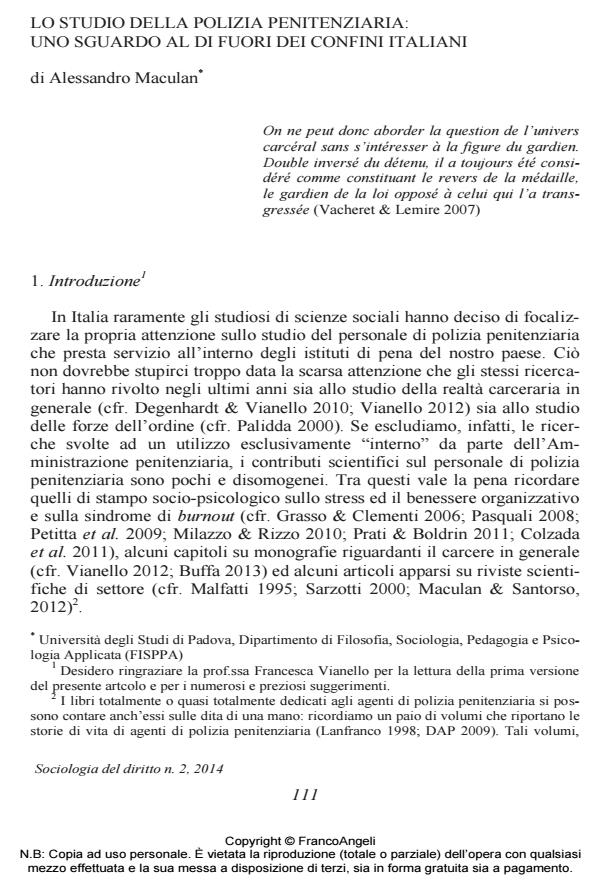Lo studio della polizia penitenziaria: uno sguardo al di fuori dei confini italiani
Titolo Rivista SOCIOLOGIA DEL DIRITTO
Autori/Curatori Alessandro Maculan
Anno di pubblicazione 2015 Fascicolo 2014/2
Lingua Italiano Numero pagine 26 P. 111-136 Dimensione file 137 KB
DOI 10.3280/SD2014-002005
Il DOI è il codice a barre della proprietà intellettuale: per saperne di più
clicca qui
Qui sotto puoi vedere in anteprima la prima pagina di questo articolo.
Se questo articolo ti interessa, lo puoi acquistare (e scaricare in formato pdf) seguendo le facili indicazioni per acquistare il download credit. Acquista Download Credits per scaricare questo Articolo in formato PDF

FrancoAngeli è membro della Publishers International Linking Association, Inc (PILA)associazione indipendente e non profit per facilitare (attraverso i servizi tecnologici implementati da CrossRef.org) l’accesso degli studiosi ai contenuti digitali nelle pubblicazioni professionali e scientifiche
In Italia raramente gli studiosi di scienze sociali hanno affrontato lo studio del personale di polizia penitenziaria che presta servizio negli istituti di pena italiani. Ciò non è avvenuto all’estero, ed in particolar modo nel mondo anglo-sassone, dove le ricerche su questo tema hanno cominciato a svilupparsi a partire dagli anni Settanta del secolo scorso permettendo una comprensione sicuramente più approfondita e ricca dell’universo carcerario. L’obiettivo di questo articolo è quello di ripercorrere i principali campi di ricerca assieme ai risultati degli studi che sono stati svolti al di fuori dei nostri confini nazionali sul personale addetto alla sorveglianza della popolazione detenuta. Ci si focalizza, così, sulla loro cultura organizzativa, sul processo attraverso cui si diventa agenti, sulle relazioni con i detenuti, sull’influenza del genere nel loro lavoro e sulle conseguenze del lavoro all’intero delle carceri.
Parole chiave:Polizia penitenziaria - Carcere - Stato dell’arte - Lavoro in carcere - Ricerca in carcere
- The "left" and "right" arm of the prison: Prison work and the local legal culture of the penitentiary Alessandro Maculan, Luca Sterchele, in Oñati Socio-Legal Series /2022 pp.1492
DOI: 10.35295/osls.iisl/0000-0000-0000-1310 - Bourdieu in carcere Alessandro Maculan, in Sociologia del diritto /2023
DOI: 10.54103/1972-5760/20943 - Doing Shifts Serena Franchi, pp.33 (ISBN:978-3-031-44552-1)
Alessandro Maculan, Lo studio della polizia penitenziaria: uno sguardo al di fuori dei confini italiani in "SOCIOLOGIA DEL DIRITTO " 2/2014, pp 111-136, DOI: 10.3280/SD2014-002005